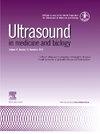通过增加神经母细胞瘤异种移植物的血管通透性和灌注,使用大小分选的微气泡进行超声渗透可协同提高L-DOX的存活率并增强肿瘤凋亡。
IF 2.4
3区 医学
Q2 ACOUSTICS
引用次数: 0
摘要
目的:尽管采取了积极的治疗措施,但约有 50%的神经母细胞瘤(NB)患者没有得到治疗,幸存者终生忍受着毒副作用。超声渗透通过聚焦超声和微气泡(MBs)--充满气体、对声音敏感的脂质球体--破坏细胞双分子层来增加药物吸收。微气泡对特定超声脉冲(空化)的反应因微气泡大小而异。我们的问题是,与多分散微泡(PMB,直径为 0.5-10 µm)相比,直径为 4-5 µm 的按大小排列的微泡(SSMB)是否能更稳定、更可预测地提高多柔比星的吸收,从而增加对 NB 异种移植的药物输送。小鼠在低负压(0.6 兆帕)或高负压(2 兆帕)下接受 PMB 或 SSMB 声波渗透。一些小鼠还接受了不同的化疗药物(多柔比星、依托泊苷或环磷酰胺)。治疗 1 小时后,通过流式细胞术对循环肿瘤细胞进行评估。对小鼠的存活期进行了长达 21 天的评估,并在治疗 24 小时后对部分小鼠实施安乐死,以对凋亡、血管腔大小和紧密连接进行组织学评估:结果:经 SSMB 和高压处理的肿瘤与脂质体多柔比星(L-DOX)产生协同作用,原因是血管腔增大和紧密连接被破坏,导致药物吸收、凋亡、肿瘤不生长和存活率提高。我们发现循环肿瘤细胞的数量没有差异:结论:2 兆帕的 SSMB 声波渗透与 L-DOX 给药具有协同作用,可增加细胞凋亡、灌注和血管通透性,这表明 SSMB 高压超声渗透有望用于 NB 靶向治疗,尤其是与 L-DOX 联合使用。本文章由计算机程序翻译,如有差异,请以英文原文为准。
Sonopermeation With Size-sorted Microbubbles Synergistically Increases Survival and Enhances Tumor Apoptosis With L-DOX by Increasing Vascular Permeability and Perfusion in Neuroblastoma Xenografts
Objective
Despite aggressive therapy, approximately 50% of patients with neuroblastoma (NB) fail to respond, and survivors endure lifelong toxicities. Sonopermeation increases drug uptake via cell bilayer disruption through focused ultrasound and microbubbles (MBs)—gas-filled, sound sensitive lipid spheres. MB response to a given ultrasound pulse (cavitation) varies according to MB size. We asked whether size-sorted MBs (SSMB) 4 to 5 µm in diameter will more consistently and predictably enhance doxorubicin uptake, compared with polydisperse MBs (PMB, 0.5–10 µm in diameter), thereby increasing drug delivery to NB xenografts.
Methods
Human NB cells were implanted into the left kidney of nude mice and grown for 5 to 6 wk. Mice received sonopermeation alongside either PMB or SSMB at low (0.6 MPa) or high (2 MPa) negative pressures. Some mice also received different chemotherapy agents (doxorubicin, etoposide or cyclophosphamide). Circulating tumor cells were assessed by flow cytometry 1 h after treatment. Survival was assessed for up to 21 d, a subset of mice was euthanized 24 h after treatment for histological assessment of apoptosis, vascular lumen size and tight junctions.
Results
Tumors treated with SSMB and high pressure showed synergy with liposomal doxorubicin (L-DOX) owing to increased vascular lumen and disruption of tight junctions, resulting in drug uptake, apoptosis, lack of tumor growth and increased survival. We found no difference in the numbers of circulating tumor cells.
Conclusion
Sonopermeation with SSMB at 2 MPa synergizes with L-DOX delivery, increasing apoptosis, perfusion and vascular permeability, suggesting that SSMB sonopermeation at high pressure is promising for NB-targeted treatment, especially in combination with L-DOX.
求助全文
通过发布文献求助,成功后即可免费获取论文全文。
去求助
来源期刊
CiteScore
6.20
自引率
6.90%
发文量
325
审稿时长
70 days
期刊介绍:
Ultrasound in Medicine and Biology is the official journal of the World Federation for Ultrasound in Medicine and Biology. The journal publishes original contributions that demonstrate a novel application of an existing ultrasound technology in clinical diagnostic, interventional and therapeutic applications, new and improved clinical techniques, the physics, engineering and technology of ultrasound in medicine and biology, and the interactions between ultrasound and biological systems, including bioeffects. Papers that simply utilize standard diagnostic ultrasound as a measuring tool will be considered out of scope. Extended critical reviews of subjects of contemporary interest in the field are also published, in addition to occasional editorial articles, clinical and technical notes, book reviews, letters to the editor and a calendar of forthcoming meetings. It is the aim of the journal fully to meet the information and publication requirements of the clinicians, scientists, engineers and other professionals who constitute the biomedical ultrasonic community.

 求助内容:
求助内容: 应助结果提醒方式:
应助结果提醒方式:


